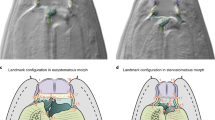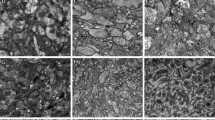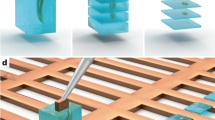Abstract
The flatworm Schmidtea mediterranea is an emerging model species in fields such as stem cell biology, regeneration and evolutionary biology. Excellent molecular tools have been developed for S. mediterranea, but ultrastructural techniques have received far less attention. Processing specimens for histology and transmission electron microscopy (TEM) is notoriously idiosyncratic for particular species or specimen types. Unfortunately, however, most methods for S. mediterranea described in the literature lack numerous essential details, and those few that do provide them rely on specialized equipment that may not be readily available. Here we present an optimized protocol for ultrastructural preparation of S. mediterranea. The protocol can be completed in 6 d, much of which is 'hands-off' time. To aid with troubleshooting, we also illustrate the major effects of seemingly minor variations in fixative, buffer concentration and dehydration steps. This procedure will be useful for all planarian researchers, particularly those with relatively little experience in tissue processing.
This is a preview of subscription content, access via your institution
Access options
Subscribe to this journal
Receive 12 print issues and online access
$259.00 per year
only $21.58 per issue
Buy this article
- Purchase on Springer Link
- Instant access to full article PDF
Prices may be subject to local taxes which are calculated during checkout





Similar content being viewed by others
References
Newmark, P.A., Reddien, P.W., Cebrià, F. & Sánchez Alvarado, A. Ingestion of bacterially expressed double-stranded RNA inhibits gene expression in planarians. Proc. Natl. Acad. Sci. USA 100 (suppl. 1): 11861–11865 (2003).
Hayashi, T., Asami, M., Higuchi, S., Shibata, N. & Agata, K. Isolation of planarian X-ray-sensitive stem cells by fluorescence-activated cell sorting. Dev. Growth Differ. 48, 371–380 (2006).
Robb, S.M.C., Ross, E. & Sánchez Alvarado, A. SmedGD: the Schmidtea mediterranea genome database. Nucleic Acids Res. 36, D599–D606 (2008).
Adamidi, C. et al. De novo assembly and validation of planaria transcriptome by massive parallel sequencing and shotgun proteomics. Genome Res. 21, 1193–1200 (2011).
King, R.S. & Newmark, P.A. In situ hybridization protocol for enhanced detection of gene expression in the planarian Schmidtea mediterranea. BMC Dev. Biol. 13, 8 (2013).
Rouhana, L. et al. RNA interference by feeding in vitro-synthesized double-stranded RNA to planarians: methodology and dynamics. Dev. Dyn. 242, 718–730 (2013).
Salvenmoser, W., Egger, B., Achatz, J.G., Ladurner, P. & Hess, M.W. Electron microscopy of flatworms: standard and cryo-preparation methods. Methods Cell Biol. 96, 307–330 (2010).
Rompolas, P., Azimzadeh, J., Marshall, W.F. & King, S.M. Analysis of ciliary assembly and function in planaria. Methods Enzymol. 525, 245–264 (2013).
Pellettieri, J. et al. Cell death and tissue remodeling in planarian regeneration. Dev. Biol. 338, 76–85 (2010).
Rink, J.C., Vu, H.T.-K. & Alvarado, A.S. The maintenance and regeneration of the planarian excretory system are regulated by EGFR signaling. Development 138, 3769–3780 (2011).
Hurbain, I. & Sachse, M. The future is cold: cryo-preparation methods for transmission electron microscopy of cells. Biol. Cell 103, 405–420 (2011).
Rouhana, L., Vieira, A.P., Roberts-Galbraith, R.H. & Newmark, P.A. PRMT5 and the role of symmetrical dimethylarginine in chromatoid bodies of planarian stem cells. Development 139, 1083–1094 (2012).
Forsthoefel, D.J. et al. An RNAi screen reveals intestinal regulators of branching morphogenesis, differentiation, and stem cell proliferation in planarians. Dev. Cell 23, 691–704 (2012).
Chong, T., Collins, J.J., Brubacher, J.L., Zarkower, D. & Newmark, P.A. A sex-specific transcription factor controls male identity in a simultaneous hermaphrodite. Nat. Commun. 4, 1814 (2013).
Sikes, J.M. & Newmark, P.A. Restoration of anterior regeneration in a planarian with limited regenerative ability. Nature 500, 77–80 (2013).
Bowers, B. & Maser, M. Artifacts in fixation for biological electron microscopy. In Artifacts in Biological Electron Microscopy (eds. Crang, R.F.E. & Klomparens, K.L.) 13–42 (Plenum Press, 1988).
Reid, N. Ultramicrotomy (North-Holland/American Elsevier, 1975).
Hayat, M.A. Principles and Techniques of Electron Microscopy: Biological Applications (Macmillan, 1989).
Bozzola, J.J. Electron Microscopy: Principles and Techniques for Biologists. (Jones and Bartlett, 1999).
Dykstra, M.J. & Reuss, L.E. Biological Electron Microscopy: Theory, Techniques, and Troubleshooting (Kluwer Academic/Plenum Publishers, 2003).
Graham, L. & Orenstein, J.M. Processing tissue and cells for transmission electron microscopy in diagnostic pathology and research. Nat. Protoc. 2, 2439–2450 (2007).
Wu, S., Baskin, T.I. & Gallagher, K.L. Mechanical fixation techniques for processing and orienting delicate samples, such as the root of Arabidopsis thaliana, for light or electron microscopy. Nat. Protoc. 7, 1113–1124 (2012).
Hayat, M.A. Glutaraldehyde: role in electron microscopy. Micron Microsc. Acta 17, 115–135 (1986).
Richards, F.M. & Knowles, J.R. Glutaraldehyde as a protein cross-linkage reagent. J. Mol. Biol. 37, 231–233 (1968).
Sabatini, D.D., Bensch, K. & Barnett, R.J. Cytochemistry and electron microscopy: the preservation of cellular ultrastructure and enzymatic activity by aldehyde fixation. J. Cell Biol. 17, 19–58 (1963).
Hayat, M.A. Fixation for Electron Microscopy (Academic Press, 1981).
Kiernan, J.A. Histological and Histochemical Methods: Theory and Practice (Scion Publishing, 2008).
Karnovsky, M.J. A formaldehyde-glutaraldehyde fixative of high osmolality for use in electron microscopy. J. Cell Biol. 27, 137A (1965).
Karnovsky, M.J. The ultrastructural basis of capillary permeability studied with peroxidase as a tracer. J. Cell Biol. 35, 213–236 (1967).
Glauert, A.M. & Lewis, P.R. Biological Specimen Preparation for Transmission Electron Microscopy (Princeton University Press, 1998).
Migneault, I., Dartiguenave, C., Bertrand, M.J. & Waldron, K.C. Glutaraldehyde: behavior in aqueous solution, reaction with proteins, and application to enzyme crosslinking. BioTechniques 37, 790–796, 798–802 (2004).
Kirkeby, S., Moe, D., Jakobsen, P., Rømert, P. & Matthiessen, M.E. Polymeric aldehyde preparations: their chemistry and fixation capacity. Micron Microsc. Acta 20, 217–221 (1989).
Prentø, P. Glutaraldehyde for electron microscopy: a practical investigation of commercial glutaraldehydes and glutaraldehyde-storage conditions. Histochem. J. 27, 906–913 (1995).
Ruzin, S.E. Plant Microtechnique and Microscopy (Oxford University Press, 1999).
Gremigni, V. & Falleni, A. Ultrastructural features of cocoon-shell globules in the vitelline cells of neoophoran platyhelminths. Hydrobiologia 227, 105–111 (1991).
Litwin, J.A. Light microscopic histochemistry on plastic sections. Prog. Histochem. Cytochem. 16, 1–84 (1985).
Sanderson, J.B. Biological Microtechnique (BIOS Scientific, 1994).
Salvetti, A. et al. DjPum, a homologue of Drosophila pumilio, is essential to planarian stem cell maintenance. Development 132, 1863–1874 (2005).
Brubacher, J.L. & Huebner, E. Development of polarized female germline cysts in the polychaete, Ophryotrocha labronica. J. Morphol. 270, 413–429 (2009).
Brubacher, J.L. & Huebner, E. Evolution and development of polarized germ cell cysts: new insights from a polychaete worm, Ophryotrocha labronica. Dev. Biol. 357, 96–107 (2011).
Cole, M.B. Jr & Ellinger, J. Glycol methacrylate in light microscopy: nucleic acid cytochemistry. J. Microsc. 123, 75–88 (1981).
Horobin, R.W. Staining plastic sections: a review of problems, explanations and possible solutions. J. Microsc. 131, 173–186 (1983).
Yang, R., Davies, C.M., Archer, C.W. & Richards, R.G. Immunohistochemistry of matrix markers in Technovit 9100 New-embedded undecalcified bone sections. Eur. Cell. Mater. 6, 57–71 (2003).
Singhrao, S.K., Müller, C.T., Gilbert, S.J., Duance, V.C. & Archer, C.W. An immunofluorescence method for postembedded tissue in the acrylic resin Technovit 9100 New using fluorescein isothiocyanate secondary detection. Microsc. Res. Tech. 72, 501–506 (2009).
Finck, H. Epoxy resins in electron microscopy. J. Biophys. Biochem. Cytol. 7, 27–30 (1960).
Mollenhauer, H.H. Plastic embedding mixtures for use in electron microscopy. Stain Technol. 39, 111–114 (1964).
Zayas, R.M. et al. The planarian Schmidtea mediterranea as a model for epigenetic germ cell specification: analysis of ESTs from the hermaphroditic strain. Proc. Natl. Acad. Sci. USA 102, 18491–18496 (2005).
Sánchez Alvarado, A., Newmark, P.A., Robb, S.M. & Juste, R. The Schmidtea mediterranea database as a molecular resource for studying platyhelminthes, stem cells and regeneration. Development 129, 5659–5665 (2002).
Cebrià, F. & Newmark, P.A. Planarian homologs of netrin and netrin receptor are required for proper regeneration of the central nervous system and the maintenance of nervous system architecture. Development 132, 3691–3703 (2005).
Van der Wal, U.P. & Dohmen, M.R. A method for the orientation of small and delicate objects in embedding media for light and electron microscopy. Stain Technol. 53, 56–58 (1978).
Venable, J.H. & Coggeshall, R. A simplified lead citrate stain for use in electron microscopy. J. Cell Biol. 25, 407–408 (1965).
Franquinet, R. & Lender, T. Quelques aspects ultrastructuraux de la spermiogenèse chez Polycelis tenuis et Polycelis nigra (planaires). Z. Mikrosk.-Anat. Forsch. 86, 481–495 (1972).
Acknowledgements
We thank L.-A. Miller (Materials Research Laboratory) and S. Robinson (Imaging Technology Group, Beckman Institute) at the University of Illinois, and A. Dufresne (Department of Biological Sciences) at the University of Manitoba, for maintenance of the transmission electron microscope facilities used by the authors. This work was supported by Canadian Mennonite University (Dean's Research Fund and Faculty Research Grant to J.L.B.) and the US National Institutes of Health (R01 HD043403 to P.A.N.). P.A.N. is an investigator of the Howard Hughes Medical Institute.
Author information
Authors and Affiliations
Contributions
All authors helped to conceive the project. A.P.V. optimized the protocol and prepared most of the specimen blocks from which the images in this paper were obtained. J.L.B. sectioned and imaged the specimens, and drafted the manuscript. All authors helped to revise the manuscript and approved the final version.
Corresponding author
Ethics declarations
Competing interests
The authors declare no competing financial interests.
Integrated supplementary information
Supplementary Figure 1 Specimens fixed in aged glutaraldehyde.
a-c: Light micrographs of thick (0.5 μm) longitudinal sections, stained with toluidine blue. The dorsal side of the worms is up. Unless otherwise noted, specimens were processed according to the standard protocol described in the paper, but using aged glutaraldehyde (stored 4 years at 4°C). Of 8 specimens examined, poor fixation was pronounced in the 3 thickest (>400 μm thick along the dorsoventral axis) of which a and b are examples, and only apparent in 1 of 5 specimens less than 400 μm thick. This latter specimen (350 μm thick) is shown in c. a,b: Arrowheads indicate poorly fixed regions, evident as weak staining due to loss of tissue components. The boxed region in a is illustrated in d at higher magnification. c: Boxed regions – well fixed on left, poorly fixed on right – are shown at higher magnification in f and g, respectively; lu: intestinal lumen – likely a channel for fixative penetration, which explains the better fixation in its vicinity. d: Higher magnification view of boxed region from a. The boxed region corresponds to that illustrated by the transmission electron micrograph in e. Asterisks indicate lipid droplets in intestinal phagocytes, whose distinctive greenish colour is due to osmication. This greenish colour is evident in residual material left in extracted lipid droplets (o, arrows) suggesting that osmium (secondary fixative) did penetrate to central areas of the worm, and poor fixation is therefore not due to inadequate osmication. e: Transmission electron micrograph of lead-stained, thin (70 nm) section, roughly 1 μm deep to boxed region in d. Electron-dense material is evident in the largely extracted lipid droplets (arrows, top-left inset), correlating with the osmiophilic residue indicated in d. Extraction of cytoplasmic ground substance is evident in the bottom inset, showing a muscle fibre (m) and cytoplasm of an adjacent intestinal phagocyte (cy), providing further evidence that the poor fixation is due to inadequate aldehyde fixation, rather than incomplete osmication. f,g: Higher magnification views of boxed regions in c (intestinal phagocytes). Material in f is well fixed, while much material has been lost from the region illustrated in g. Note the relative lack of basophilic material in the cytoplasm, and the weak staining of material in the cores of the storage granules (+) in panel g, as compared to f. The extraction of material from the cores of lipid droplets (*) in f is due to the dehydration procedure used for this specimen (see Figure 3) and not fixation per se. Scale bars: a-c: 200 μm, d, f, g: 20 μm, e: 6 μm (2 μm for insets).
Supplementary Figure 2 Illustrations for steps 5 and 18.
a: To minimize physical damage to worms in step 5, they should be cut after a brief initial fixation using a rocking “guillotine” motion using a scalpel with a rounded end. The rocking motion initiates cutting of tissue at the thinnest point of the worm's body, and reduces compression by minimizing the diameter of the worm in contact with the blade at any time. b: Drawing of one end of a wooden applicator stick. To produce a mini-spatula as described in step 18, carve one end of the stick into a thin, flat surface by whittling as indicated by the dashed lines in this image.
Supplementary information
Supplementary Figure 1
Specimens fixed in aged glutaraldehyde. (PDF 26005 kb)
Supplementary Figure 2
Illustrations for steps 5 and 18. (PDF 940 kb)
Supplementary Table 1
Chemical fixation methods described for resin embedding of Schmidtea mediterranea, 2010–present. (PDF 97 kb)
Rights and permissions
About this article
Cite this article
Brubacher, J., Vieira, A. & Newmark, P. Preparation of the planarian Schmidtea mediterranea for high-resolution histology and transmission electron microscopy. Nat Protoc 9, 661–673 (2014). https://doi.org/10.1038/nprot.2014.041
Published:
Issue Date:
DOI: https://doi.org/10.1038/nprot.2014.041
This article is cited by
-
Forkhead containing transcription factor Albino controls tetrapyrrole-based body pigmentation in planarian
Cell Discovery (2016)
-
Ultrastructure of embryonated eggs of the cestode Gyrocotyle urna (Gyrocotylidea) using cryo-methods
Zoomorphology (2016)
-
Generation of cell type-specific monoclonal antibodies for the planarian and optimization of sample processing for immunolabeling
BMC Developmental Biology (2014)
Comments
By submitting a comment you agree to abide by our Terms and Community Guidelines. If you find something abusive or that does not comply with our terms or guidelines please flag it as inappropriate.



